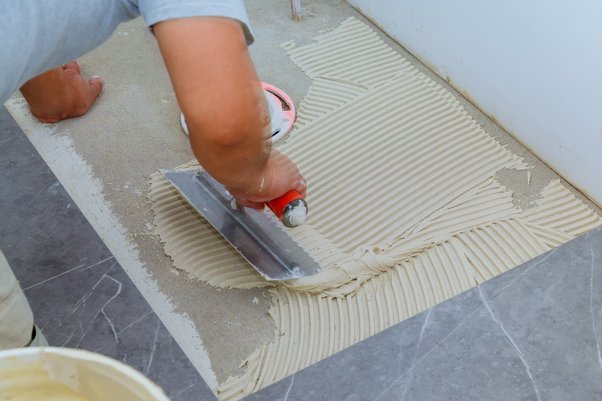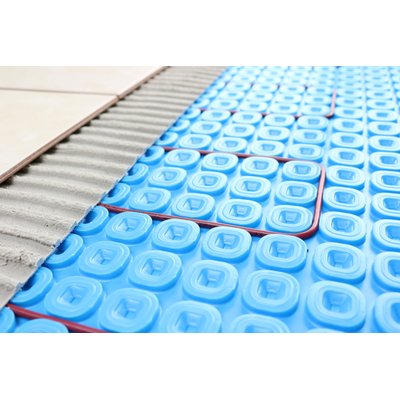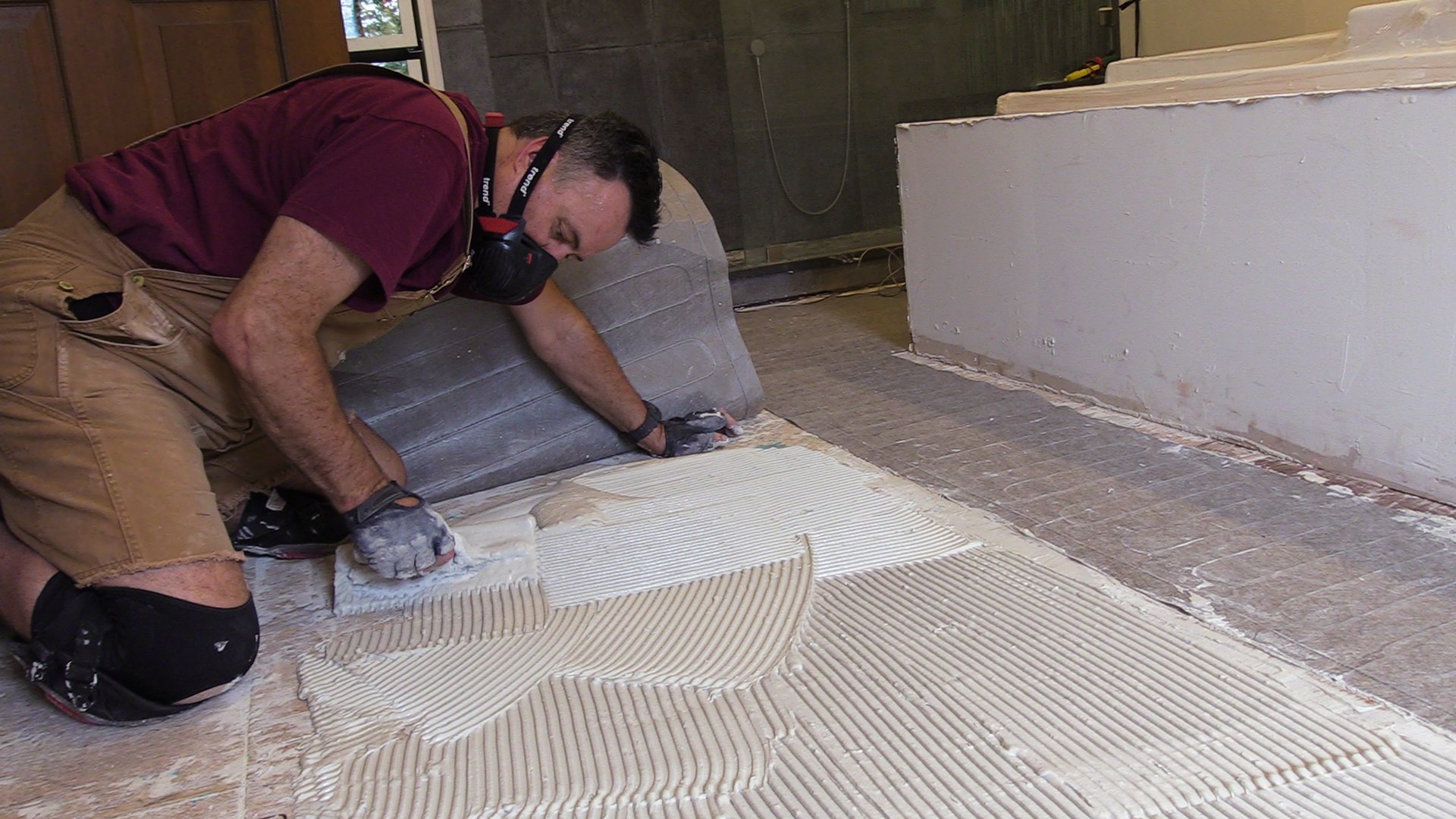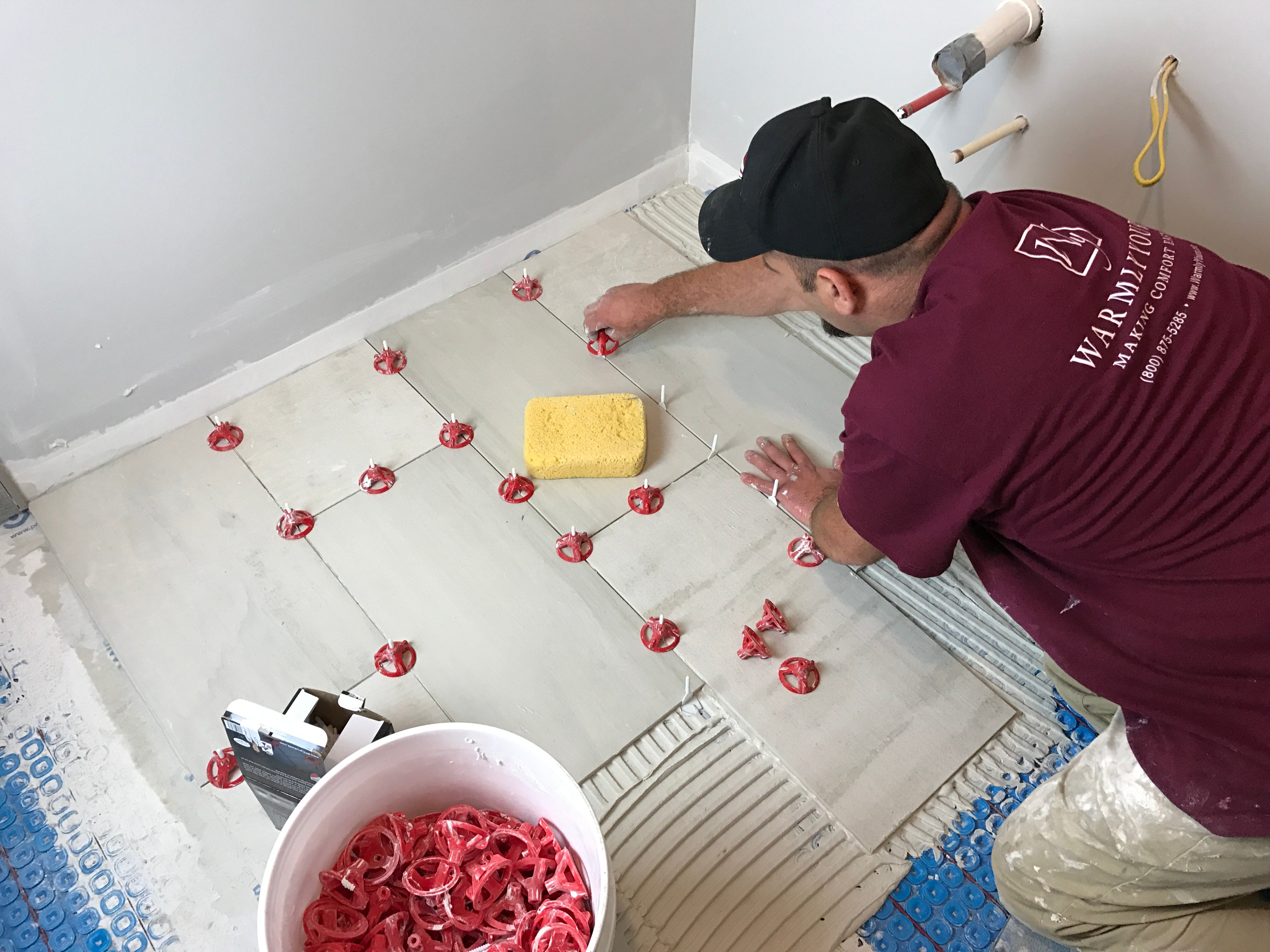Table of Contents
- What is Thinset?
- The Rise of Modified Thinset
- Unmodified vs. Modified Thinset: Key Differences
- When to Use Unmodified Thinset
- Choosing the Right Thinset for Your Tile Installation
- How to Properly Mix and Apply Thinset
- Thinset Tips
- Common Mistakes to Avoid When Using Thinset
- Thinset and Radiant Floor Heating Systems
- Frequently Asked Questions (FAQs)
What happens when you inject something with ingredients designed to make it stronger? In the movies (or comics), you get characters like Wolverine. But real life has some stories to tell as well.
Take thinset, for instance. Back in the 1940s, people used 2-3 inches of thinset beneath their tile. That’s because they needed to make sure that the cement had enough moisture to fully cure. If there wasn’t enough moisture, the thinset wouldn’t be strong enough to bond the tile to the subfloor.
Unmodified thinset consists simply of cement, finely graded sand and water retention agents. It’s mixed with water before it’s ready to be spread out on the subfloor.
What is Thinset?
Thinset, also known as thinset mortar or dryset mortar, is an adhesive material used to install tiles on floors, walls, and countertops. It is a mixture of cement, fine sand, and water retention agents that forms a strong bond between the tile and the substrate surface.
The Rise of Modified Thinset

To help strengthen thinset, Henry Rothberg invented a synthetic form of latex to be added to the thinset, thereby kickstarting the whole segment of modified thinsets. He took inspiration from modified concrete mixes of the 1920s that were used to repair and strengthen sea walls. However, he made sure that his synthetic latex had a longer shelf life and extended working time to suit tile installations.
Twenty years later, the Tile Council of America developed a modified powdered thinset with dry polymers that were activated by adding water to the mix. These modified thinsets also went back to being as their name describes — thin — thanks to their added strength. Typically, they’re applied at about 3/16 inch thick when spread out with a 3/8 inch notch trowel. And for radiant floor heating installations, the thinset must be at least 3/8 inch thick in order to embed the heating element and adhere the tile.
And tile installers haven’t looked back. Modified thinset is the product of choice for most tile installations because of its increased strength and bonding with minimal shrinkage, which means a reduced chance of cracks forming in the tile. WarmlyYours Radiant Heating recommends modified thinset mortar for nearly all tile and stone installations. However, if you’re using an uncoupling membrane, you’ll want to go “old school” and stick with unmodified thinset.
Unmodified vs. Modified Thinset: Key Differences
Unmodified thinset consists of cement, sand, and water retention agents, while modified thinset includes additional polymers or latex to enhance its performance. Modified thinset offers increased strength, flexibility, and bonding capabilities, making it suitable for a wider range of applications and substrates.
The following table compares unmodified and modified thinset:
| Feature | Unmodified Thinset | Modified Thinset |
| Composition | Cement, sand, and water retention agents | Cement, sand, water retention agents, and additional polymers or latex |
| Strength | Suitable for basic tile installations | Enhanced strength for more demanding applications |
| Flexibility | Limited flexibility | Increased flexibility to resist cracking and movement |
| Bonding | Adequate bonding for most surfaces | Superior bonding to a wider range of substrates |
| Curing | Requires moisture to cure properly | Can cure through a hydration process or by air drying |
| Application | Ideal for use with impervious flooring membranes | Recommended for most tile and stone installations |
| Thickness | Traditionally applied in thicker layers | Can be applied in thinner layers due to added strength |
| Cost | Generally less expensive | Slightly more expensive due to additional components |
| Shelf Life | Longer shelf life when stored properly | May have a shorter shelf life due to added polymers or latex |
When to Use Unmodified Thinset

A lot of the uncoupling membranes used in flooring installations are impervious, which means they will not deprive the thinset of its moisture. As a result, the unmodified thinset can properly hydrate, creating interlocking crystals that will form a strong, dense bond.
Modified thinset, on the other hand, is not recommended because it relies on air to cure properly. When sandwiched between two impervious layers — the tile and the installation membrane — drying can only take place through the open grout joints, which can take as long as 60 days! If an extended cure time is not observed before grouting, the results would be unpredictable. Therefore, it’s best to use unmodified thinset when working with an impervious installation membrane for installing radiant floor heating.
It's important to note that latex-modified thinset can still be used between the membrane and the subfloor because it is not impervious. Remember to always consult and adhere to the latest installation instructions and product recommendations for your specific brand and type of membrane.
Choosing the Right Thinset for Your Tile Installation
When selecting thinset for your project, consider factors such as the type of tile being installed, the substrate material, and the environment in which the tile will be placed. For example, use unmodified thinset when installing tiles on an impervious membrane and opt for modified thinset in most other scenarios.
How to Properly Mix and Apply Thinset
To achieve the best results, it's always best to refer to the manufacturer's instructions. However, generally speaking, to properly mix thinset you will add the dry thinset mix to the water and use a drill fitted with a mixing paddle to blend the materials until the consistency resembles frosting or peanut butter. Apply the thinset using the appropriate notched trowel size for your tile, ensuring full coverage and avoiding air gaps.
Thinset Tips
- Always add the dry thinset mix to the water — not the other way around.
- Use a drill fitted with a mixing paddle to mix the thinset.
- Mix the thinset as if you’re mixing batter. Start slowly so as not to splash the powder or water out of the bucket and stop when it’s the consistency of frosting or peanut butter.
- Only make enough thinset that you can use within 20-30 minutes. This will prevent hardening in the bucket.
- To test if the thinset is still viable to use, test it with your finger. If the thinset sticks to your finger, it should still stick to the surface being tiled. If not, throw it out and start a new batch.
- Ensure that there are no air gaps during application of thinset.
- Make sure the heating cable, factory splices, and low-voltage thermostat sensor (if used) are completely embedded in the thinset.
- Don’t turn on the radiant heating system until the embedding thinset has fully cured. Turning the system on before the thinset has cured could cause the thinset to become brittle. This type of system failure will not be covered by most industry warranties. It usually takes 2-28 days for thinset to fully cure but make sure to defer to curing times provided by the manufacturer for the thinset you’re using in your project.

Common Mistakes to Avoid When Using Thinset
Some common mistakes to avoid when working with thinset include adding water to the dry mix (instead of adding the dry mix to the water), using thinset that has begun to harden, and failing to fully embed heating cables, factory splices, or floor sensors in the thinset. Additionally, never turn on a radiant heating system until the thinset has fully cured, as this can cause the thinset to become brittle.
Thinset and Radiant Floor Heating Systems
When installing radiant floor heating systems, it is crucial to use the appropriate type of thinset and follow the manufacturer's guidelines. WarmlyYours recommends using modified thinset for most tile and stone installations, with the exception of installations involving uncoupling membranes, which typically require unmodified thinset between the membrane and the tile.
Frequently Asked Questions (FAQs)
Here are some of the most common questions we get about these types of thinset.
How long does thinset take to cure fully?
This depends on a lot of variables (to name a few: the depth of the layer of thinset, the width of the grout lines in the tile, the ambient dryness in the room, etc.) so the best bet is to refer to the thinset manufacturer's instructions.
Can I use leftover thinset that has begun to harden?
It is unlikely that you would have time to use this thinset before it becomes too hard unless you already have a project lined up.
What happens if I turn on the radiant heating system before the thinset has cured?
You don't want to do this because if you do, you can cause the thinset to become brittle.
Is it necessary to use a notched trowel when applying thinset?
Yes, this type of trowel has been designed for applying thinset because it creates not only even applications in crenelated rows but it also prevents air bubbles which can happen with flat edged trowels.
Can I use modified thinset for all tile installations?
No, there are some applications where the thinset will be sandwiched between two impervious layers which would make curing modified thinset take far longer than is practical. That being said, modified thinset is the go-to choice for most tile installations.
Have Questions About Your Project?
Our team of Radiant Experts is ready to help!
Comments





So basically use unmodified thinset for tile over concrete, not concrete board but concrete itself.
If you're just installing the tile over the concrete subfloor, then unmodified thinset is a good choice. However, if you're incorporating a floor heating system over a concrete subfloor, we recommend installing an insulating underlayment to prevent heat-loss to the slab. That underlayment is typically adhered to the subfloor with modified thinset and the heating system is embedded on top of it with either modified thinset or self-leveling cement before the tile is set.
What would cause cement tiles installed above radiant heat to start to crack soon after install? Factors: I'm not sure what kind of thinset was used (mod or unmod). Not sure tiles were backbuttered. Not sure if tiles were moistened before install so as not to pull moisture from the thinset. Not sure if enough force was used to get a solid layer of thinset into the Ditra Heat mat so there was not any voids/air spaces under the tile. I also think the cable was run 2 studs apart from each other rather than the 3 studs specified in the Ditra install guide. Any experience with cement tiles cracking over heat? I am leaning toward having the job taken out and done over again (following all the installation guidelines) but don't want to do that if the same result might happen. Thanks.
That's a really good question, and, as you identified, it's a question with a lot of factors that have to be considered. If the wrong thinset/adhesive was used, or if the thinset wasn't mixed correctly, or if the system was turned on before the thinset was fully cured, that could certainly be a cause of cement tile cracking. It's also possible that a subfloor issue (too much give in a wood subfloor or cracks telegraphing from a slab) could be the culprit. As far as the spacing of the cables in the membrane, if the heating cable is not spaced far enough apart it could cause problems for the system eventually, but it shouldn't be the reason your floor is cracking. Our sales manager has reached out to you via email and hopefully, with some more information, we'll be able to help more.
I just purchased some Prodeso from a tile company that suggests I use modified thin set when I attach the tiles so I’m a little confused because that is exactly opposite of what this article says. They sell 253 Laticrete modified thin set. Also, is it a problem if there is not good adherence between the membrane and the subfloor. My contractor seemed to go a little light in the modifued thinseg under the membrane.
My tile vendor is selling modified thin set to adhere the tiles. That seems to be exactly what you say not to do. They sell Laticrete modified thin set. What to do?
Based on the latest information from Prodeso, modified or unmodified thinset can be used over the membrane, and tile manufacturer may need to suggest on the specific type. Please see the cross-section here: https://www.warmlyyours.com/en-US/publications/TEMPZONE-CABLE-PRODESO-HEAT-MEMBRANE-CROSS-SECTION-A.pdf Also we recommend to periodically check coverage of the membrane to the subfloor; in case of partial coverage, it is recommended to increase the amount of adhesive or its fluidity. Please see page 14 of the Installation Manual here: https://www.warmlyyours.com/en-US/publications/PRODESO-MEMBRANE-INSTALLATION-MANUAL-A.pdf If you need additional assistance, you can reach our 24/7 Technical Support by dialing 1-800-875-5285.
Can unmodified thinset mortor be used over plywood subfloor to install hardie board? AOW
That's a great question, and while we always recommend deferring to the manufacturer's installation documentation as the primary source of information, it does appear that unmodified thinset can be used between the Hardie cement board and the subfloor. You can find their complete instructions on this page: https://www.jameshardie.com/products/hardiebacker-cement-board#getstarted
So, I understand that if I am installing Mosaic tile on a mirror (both impervious surfaces) I should use UNmodified Thinset. Correct?
Thank you for the question and that is a very unique application. You'll want to defer to the thinset manufacturer's information regarding that application and the proper installation methods but from the information you've provided it does seem like unmodified would be the best choice.
Is It necessary to use RedGard before installing porcelain tile on cement floor? Which mortar is best recommended for very cold weather?
Thanks for the questions but the answers will depend on the electric code in your area and which mortar you use. You'll need to defer to your local code about whether or not it's required to install a waterproofing membrane like RedGard (often it's not required). And typically you'll need to refer to the manufacturer's guidelines about weather stipulations for a mortar but in our experience this isn't usually an issue.
Please advise what to use over the WarmlyYours electric heat cables when I will be putting engineered hardwood on top. So far the floor consists of plywood then the cables. Next step latex modified thinset? What about a self leveling compound? Is a moisture barrier needed? Do I need a felt or foam underlayment?
That's a great question but the answer will likely depend on how the floor covering is being installed (floating vs. glued down) and what type of heating element you have. For a floating floor using our Environ Flex Roll or Easy Mat product, you won't likely need an adhesive on top of the heating element but you should have an underlayment like cork sheets above the subfloor but beneath the heating elements. If you're gluing down the engineered wood and using our TempZone heating elements, then you don't need an underlayment unless the installation is below grade but you will likely want to use a self-leveling compound to embed the heating elements (which will create a nice flat surface to install the floor covering over). In either case, a moisture barrier is almost certainly not required. We can definitely provide more information if you want to give us a call at 1-800-875-5285.
Getting some mixed answers on what thinset i should use when installing porcelain tiles over concrete. Please advise . Thanks
Whether you're installing floor heating under your porcelain tiles or not (if so, we recommend using an uncoupling membrane with floor heating cable to help protect your floor from foundational movement and telegraphing cracks from the subfloor), you should be using a latex-modified thinset. Hope that helps!
Want to install CeraZorb insulating underpayment on sealed concrete then tile. What thinset a should be used for each of these two applications.
Thanks for reading and taking the time to submit this question. From the information you've provided, it sounds like you would want to use latex-modified thinset for both adhering the CeraZorb insulating underlayment to the concrete subfloor and for adhering the tile. If you have any further questions, please don't hesitate to give us a call at 1-800-875-5285.
What are different underlaments we can use the Schluter detra we looked at using is very pricey
Thanks for taking the time to ask a question! An uncoupling membrane, like the Schluter Ditra or even the Prodeso Cable Installation Membrane that we sell, will add costs to a project and while they have a lot of benefits like crack isolation and speedy installation, they might not be necessary. The per sq. ft. cost of a cable system can go from $9 a foot with Prodeso to $6 a foot with just fixing strips. However, if your project does require the use of an uncoupling membrane, then my best suggestion (beyond comparison shopping) would be to keep an eye out for refurbished products from suppliers that sell them online (like ours here: https://www.warmlyyours.com/en-US/sales/refurbished) sometimes you'll find a roll of underlayment that is significantly discounted but functionally the same. Hope that helps!
i just pulled up all the carpet in my home (which is 20 years old) to put down some porcelin tile and saw some huge cracks in the concrete. I have gotten different advice like "it's Florida where it's hot, concrete is going to crack, nothing to be concerned about" to the other extreme, you should not put porcelin tile down if your concrete floor has cracks, even if you do think everything has settled over 20 years now. I was told by one person "just use a modified thin set that will flex a little" and go ahead with your tile plans" ... i'm not sure what that is and if that is the same advice as someone else to "use a self leveling underlayment" and you'll be ok. Are those two pieces of advice the same thing or is one more preferable than the other...(and should I try to fill in the cracks with something--some areas are wide enough to put a penny in)
Thanks for reaching out! Unfortunately, you'll probably have to engage a structural engineer to assess your foundational issues. However, I do want to be clear that using self-leveling underlayment and using modified thinset are not exactly the same thing and neither will be a permanent solution if you do have significant foundational movement. The self-leveling compound will just cover and fill in the existing cracks but will have almost no impact on further foundational movement. The modified thinset would just adhere the tile to the subfloor directly so any foundational movement could lead to popped tiles or even cracked ones. Again, our recommendation is to contact a structural engineer but another option is using an uncoupling membrane. The uncoupling membrane would be adhered to your subfloor but it would "uncouple" your subfloor and the finished tile floor, meaning that you'll have more leeway if cracks in the subfloor telegraph upwards.